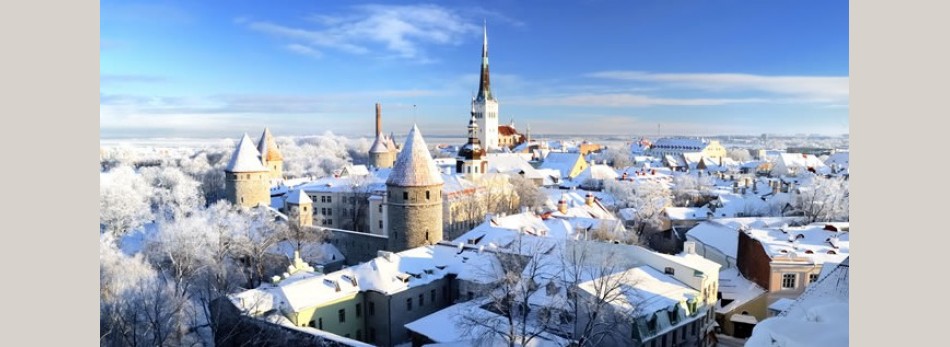Estonian

Estonian (Eesti keel) is a member of the Finnic branch of the Uralic language family. It is related to Võro, Vod and Finnish, the latter spoken on the other side of the Gulf of Finland. It is also distantly to Hungarian spoken in central Europe. Finnish and Estonian share a great deal of their vocabulary. Throughout its history, Estonia was under Danish, Swedish, Teutonic, and Russian rule. In 1721, Estonia became part of the Russian Empire when Russian was declared its official language. During World War II, Estonia was annexed by the Soviet Union in 1940 and subsequently occupied by the Germans until 1944. Under the Soviet rule Estonia went through another period of russification until its independence in 1990, when Estonian became the national language.
At present, Estonian is spoken by about 1 million people in the Republic of Estonia. In addition it is spoken by another 100,000 people in Australia, Canada, Finland, Latvia, Russia, Sweden, United Kingdom, and USA (Ethnologue). It is the official language of the Republic of Estonia and one of the official languages of the European Union. Standard Estonian is used and accepted at all levels of society. After the dissolution of the USSR, Estonia became an independent republic and although Russian is still widely used as a second language, Estonian is taught in schools, and competency in it is required for citizenship.
Dialects
Estonian has two major mutually intelligible dialects,
- Northern Estonian, based on the dialect of Tallinn, the capital of Estonia
- Southern Estonian, based on the dialect of Tartu, the second-largest city in Estonia.
Structure
In general, the sound system of Estonian is similar to that of Finnish. The language is rich in vowels and relatively poor in consonants.
Vowels
Estonian has 9 vowel phonemes all of which can appear in three different lengths: simple, long, and overly long. Simple and long vowels are distinguished by relative length, whereas the so-called overly long vowels are distinguished by a tonal contour. In writing, long vowels are represented by doubling, but the overly-long vowels are not marked at all. There is a contrast between some rounded and unrounded front and back vowels. In addition, there are 19 diphthongs.
|
Front
|
Back
|
|||
|---|---|---|---|---|
|
Unrounded
|
Rounded
|
Unrounded
|
Rounded
|
|
| Close |
i
|
y
|
u
|
|
| Mid |
e
|
ø
|
ɤ
|
o
|
| Open |
æ
|
ɑ
|
||
- /y/ = second vowel in statue
- /ø/ has no equivalent in English
- /æ/ = a in cat
- /ɤ/ has no equivalent in English
- /ɑ/ = a in father
Consonants
Estonian has relatively few consonants. A distinguishing feature is the presence of palatalized consonants which were probably acquired from the neighboring Slavic languages. Palatalization is not represented in the writing system. Consonants, like the vowels, can be short, long and overly long. In orthography, long consonants are represented by double letters.
|
Bilabial
|
Labio-dental
|
Alveolar
|
Post-alveolar
|
Palatal
|
Velar
|
Glottal
|
|||
|---|---|---|---|---|---|---|---|---|---|
| Stops | voiceless | plain |
p
|
t
|
k
|
||||
| palatalized |
pʲ
|
tʲ
|
kʲ
|
||||||
| voiced | plain |
b
|
d
|
g
|
|||||
| palatalized |
bʲ
|
dʲ
|
gʲ
|
||||||
| Fricatives | voiceless | plain |
(f )
|
s
|
(ʃ)
|
h
|
|||
| palatalized |
sʲ
|
||||||||
| voiced | plain |
v
|
|||||||
| palatalized | |||||||||
| Nasals | plain |
m
|
n
|
(ŋ)
|
|||||
| palatalized |
nʲ
|
||||||||
| Lateral | plain |
l
|
|||||||
| palatalized |
lʲ
|
||||||||
| Trill |
r
|
||||||||
| Semivowels |
j
|
||||||||
- /pʲ/, /bʲ/, /tʲ/, /dʲ/, /kʲ/, /gʲ/, /nʲ/, /lʲ/ represent palatalized consonants pronounced with the blade of the tongue coming in contact with the hard palate.
- /ʃ/ = sh in shop
- /ŋ/ = ng in song
- /j/ = y in yet
- Consonants in parentheses occur only in loanwords.
- All consonants can be short or long, e.g., lina ‘linen,’ and linna ‘city.’
Stress
Stress usually falls on the first syllable of a word, but loanwords and foreign words usually retain their original stress. Vowel length makes most syllables appear evenly stressed.
Like other Uralic languages, Estonian represents a combination of agglutinative and fusional elements. In an agglutinative language, grammatical suffixes are added to stems in a sequence, with each suffix representing one grammatical function. In a fusional (inflecting) language, several grammatical functions are represented by one suffix.
Nouns
Estonian nouns are marked for the following grammatical categories.
- Nouns are not marked for gender.
- There are no articles.
- There are two numbers: singular and plural.
- There are fourteen cases. The general use cases are Nominative, and Genitive. The general locative cases are Essive, Partitive, and Translative. The interior locative cases are Inessive, Elative and Illative. The exterior locative cases are Adessive, Ablative and Allative. The restricted use cases are Instructive, Comitative and Abessive. Case and number are marked with a single suffix. The addition of a suffix often changes the length of the consonant in the stem. Despite the large number of cases, Estonian lacks the accusative case, common in Indo-European languages for denoting the direct object of a transitive verb. The direct object in Estonian is expressed by the Nominative, Genitive or Partitive cases in the singular, and by the Nominative or the Partitive cases in the plural. Using the Genitive case for the object in the singular and the Nominative case in the plural, indicates the completeness of the action. Use of the Partitive case expresses the unfinished nature of the action.
Verbs
Estonian consist of a stem + tense/mood suffix + person/number suffix.
- There are two tenses: present and past.
- There are three moods: indicative, conditional and subjunctive.
- The person/number suffix represents the person/number of the subject and the person of the object.
Word order
The normal word order in Estonian is Subject-Verb-Object. At the same time, word order in Estonian sentences is determined by topic and comment. Topic is the part of the sentence that is known, while comment is the new information that is being added about the topic. In Estonian sentences, topic comes first.
The basic vocabulary of Estonian reflects its Uralic origin. However, since throughout its modern history, Estonia has been ruled by foreign powers, most notably Germany, Sweden, and Russia, Estonian has a large number of loanwords from these languages. Other borrowings come from Finnish, French and English. Below are some common Estonian words and phrases.
| Yes | Jah |
| No | Ei |
| Hello |
Tere
|
| Good bye |
Head aega
|
| Thank you |
Tänan, aitäh
|
| Please |
Palun
|
| Excuse me |
Vabanda, vabandage
|
| Man | Mees |
| Woman | Naine |
Below are Estonian numerals 1-10.
|
1
|
2
|
3
|
4
|
5
|
6
|
7
|
8
|
9
|
10
|
|---|---|---|---|---|---|---|---|---|---|
|
üks
|
kaks
|
kolm
|
neli
|
viis
|
kuus
|
seitse
|
kaheksa
|
üheksa
|
kümme
|
Writing
The oldest records of Estonian date from the 8th century AD. The first complete texts in Estonian, the Kullamaa prayers, appeared in the 1520s, followed by other religious texts. The first grammars appeared in the early 17th century during Swedish rule. Folk songs and oral poetry were first recorded in the 18th century. The modern written form of the language began to take shape in the first half of the 19th century. The first Estonian newspapers appeared in the second half of the 19th century. Throughout most of its history, Estonian has used the Roman alphabet. Since I t was first written by German scholars, its spelling was heavily influenced by German until the 1850s when the orthography underwent a reform aimed to bring it closer to the spoken language. The present-day alphabet has seventeen consonants and nine vowels. The Estonian orthography is quite regular, meaning that each phoneme is represented by one letter. There are a few exceptions. Four vowel letters representing sounds specific to Estonian are listed at the end of the alphabet. The alphabet lacks the letters f, c, q, w, x, y which are used only for writing foreign names and loanwords. Additional letters š and ž are used for writing borrowed words.
|
A a
|
B b
|
C c
|
D d
|
E e
|
G g
|
H h
|
I i
|
J j
|
K k
|
L l
|
M m
|
|
N n
|
O o
|
P p
|
R r
|
S s
|
T t
|
U u
|
V v
|
à ã
|
Ä ä
|
Ö ö
|
Ü ü
|
Take a look at Article 1 of the Universal Declaration of Human Rights in Estonian.
| Artikkel 1. Kõik inimesed sünnivad vabadena ja võrdsetena oma väärikuselt ja õigustelt. Neile on antud mõistus ja südametunnistus ja nende suhtumist üksteisesse peab kandma vendluse vaim |
| Article 1 All human beings are born free and equal in dignity and rights. They are endowed with reason and conscience and should act towards one another in a spirit of brotherhood. |







